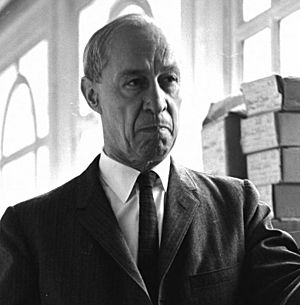Rensis Likert facts for kids
Quick facts for kids
Rensis Likert
|
|
|---|---|

Likert at the University of Michigan Institute for Social Research in 1961
|
|
| Born | August 5, 1903 |
| Died | September 3, 1981 (aged 78) |
| Resting place | Forest Hill Cemetery (Ann Arbor, Michigan) (Lot 50, Number 8) |
| Alma mater | University of Michigan Columbia University |
| Employer | USDA University of Michigan |
| Known for | Likert Scale, Likert's Management Systems, Linking pin model |
| Spouse(s) | Jane Gibson Likert |
Rensis Likert (/ˈlɪkərt/ LIK-ərt; August 5, 1903 – September 3, 1981) was an American psychologist. He studied how people behave in groups and at work. Likert is famous for creating the Likert scale. This is a way to measure people's opinions and feelings using surveys.
He also developed the idea of participative management. This is a style where employees are involved in making decisions at work. Likert's ideas helped shape how we understand people's thoughts and how organizations work.
Likert earned his first degree in economics and sociology from the University of Michigan in 1926. He later got his Ph.D. in psychology from Columbia University in 1932. He worked for the United States Department of Agriculture and the Office of War Information before joining the University of Michigan. After he retired, he started his own company, Rensis Likert Associates.
Contents
About Rensis Likert
Rensis Likert was born in 1903 in Cheyenne, Wyoming. His father was an engineer for the Union Pacific Railroad. This led Rensis to study civil engineering at the University of Michigan. During a big railroad strike in 1922, he saw how people behaved in organizations. This made him interested in studying human behavior.
He changed his major to economics and sociology. After graduating, he went to Columbia University to study psychology. There, he met his future wife, Jane Gibson. They had two daughters, Elizabeth and Patricia. In 1938, he wrote a book with his teacher, Gardner Murphy.
Likert retired in 1970 and moved to Hawaii. He later passed away in Ann Arbor, Michigan, in 1981.
Likert's Career
Early Research
In 1935, Likert became a research director for a life insurance group. He started studying how different ways of supervising workers affected their performance.
Government Work
In 1939, Likert was asked to create a survey division for the United States Department of Agriculture. This group gathered farmers' opinions on government programs during the Great Depression. During World War II, his team did surveys for many government agencies. They helped understand public opinion during the war.
Institute for Social Research
After the war, Likert and his team moved to the University of Michigan. They formed the Survey Research Center in 1946. This center later became the University of Michigan Institute for Social Research (ISR) in 1949. Likert was the director of the ISR until he retired in 1970.
After Retirement
After retiring, Likert started Rensis Likert Associates. He advised many companies based on his ideas about management. His books on management theory were very popular in Japan in the 1960s and 1970s. His studies often predicted how well companies would do in the future.
Likert's Main Ideas
Open-ended Interviewing
Likert helped develop a way of interviewing called "open-ended interviewing." This is a technique where you ask people questions that let them answer freely. In the 1930s, most surveys used questions with only "yes" or "no" answers. Likert saw that people needed more ways to share their thoughts.
He and his team created the "funneling technique." This starts with broad, open questions. Then, the questions become more specific. This method is still used today to understand people's attitudes.
Likert Scale
The Likert scale is what Rensis Likert is most famous for. He created it in 1932 for his Ph.D. project. It helps measure how strongly someone agrees or disagrees with something. For example, a survey might ask you to rate something from "Strongly Disagree" to "Strongly Agree."
The Likert scale is used in many areas. This includes marketing, customer satisfaction surveys, and studies about people's attitudes. It helps researchers understand opinions by turning answers into scores.
Management Systems
Likert also developed four main styles of management in the 1950s. These systems describe how managers and employees work together in companies. They range from very controlling to very involving:
- Exploitative Authoritative: Managers make all decisions and don't trust employees.
- Benevolent Authoritative: Managers are kind but still make most decisions.
- Consultative System: Managers ask for employee ideas but make the final decisions.
- Participative System: Managers involve employees in decisions and trust them.
Achievements
- 1932 — Developed the Likert Scale
- 1944 — Became head of the United States Strategic Bombing Survey Morale Division
- 1949 — Became a Fellow of the American Statistical Association
- 1959 — Served as President of the American Statistical Association
- 1967 — Received an honorary degree from Tilburg University, Netherlands
- Developed Open-ended Interviewing
- Introduced Participative management
Books by Likert
- Technique for the Measurement of Professional Attitudes (1932)
- New Patterns of Management (1961)
- Human Organization: Its Management and Value (1967)
- New Ways of Managing Conflict(1976, with Jane Gibson Likert)
See also
 In Spanish: Rensis Likert para niños
In Spanish: Rensis Likert para niños

